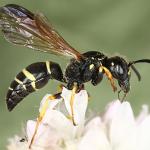Pseudepipona tomentosus THOMSON 1870
Previously known as Pseudepipona tomentosus (Thomson, 1870). Identification keys and general biology are given in Spradbery (1973), Richards (1980), Yeo & Corbet (1995) and Archer (2000).
Devon, Dorset, Berkshire and Surrey, with a nineteenth century record from West Gloucestershire. See Richards (1958), Falk (1991) and Else (1992) for further information.
Overseas found in many parts of Europe (including Norway, Sweden, Finland, Denmark, The Netherlands, Belgium, Luxembourg, France, Spain, Germany, Switzerland, Italy, Poland, Austria, Hungary, Greece, Bulgaria and Russia (Karelia)); north Africa (Morocco); and Asia (Armenia, Russia (east to far-eastern Maritime Kray), Mongolia and Japan).
Shirt (1987) lists this species as Rare (RDB3); Falk (1991) lists it as Vulnerable (RDB2). The shortage of recent records suggests its status should be reviewed.
Limestone quarries, pebble beaches and slopes of coastal cliffs. Seen flying over heather and bramble.
Univoltine; from May until August but most often seen during June and July.
Probably larvae of microlepidoptera (Tortricidae) and beetles (Chrysomelidae).
A tube-dweller, recorded nesting in holes in beach pebbles and holes in large stones. Probably also nests in burrows in dead wood. Witt (1998) illustrates a female engaged in nest building, but no further information has been found.
Dewberry and wall cotoneaster.
No British records; overseas, Kunz (1994) gives the wasp Chrysis longula Abeille de Perrin.
2001


